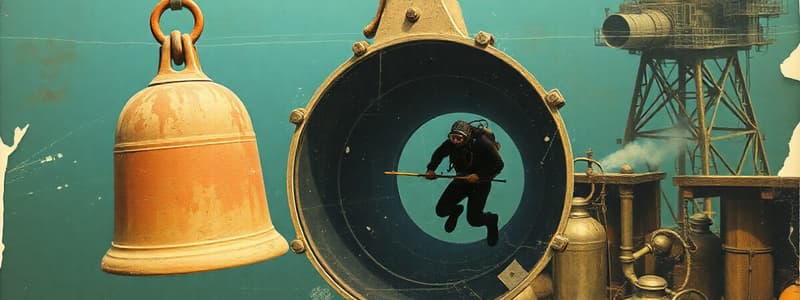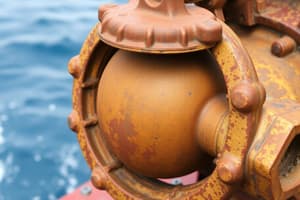Podcast
Questions and Answers
What was the likely sequence of events that led to the lifeboat detachment?
What was the likely sequence of events that led to the lifeboat detachment?
- The master link handles, being incorrectly oriented, impacted the hook safety latch, releasing the hooks; the lifeboat then swung, releasing the painters. (correct)
- The lifeboat was lowered, the falls slacked, and both master links disconnected simultaneously, after which the crew lost control of the lifeboat.
- The lifeboat swung 180 degrees, causing the aft painter to disconnect first, which was followed by the forward master link releasing the hooks.
- The forward painter disconnected first, followed by the aft painter, then the master links, leading to the lifeboat drifting away.
What primary factor contributed to the failure of the bailout manifold assembly's nuts?
What primary factor contributed to the failure of the bailout manifold assembly's nuts?
- Lateral force introduced by inappropriate securing mechanisms likely led to stress corrosion cracking and material ingress, causing internal corrosion over time. (correct)
- The nuts were made from a copper alloy CW614N, which is known to resist stress corrosion cracking and dezincification under pressure.
- The securing strap holding the bottles together was too tight, causing the nuts to fail.
- The system was over-pressurized beyond its design limits, causing immediate failure of the nuts.
Why did the lifting trunnion cover plate fall off, and what erroneous assumption contributed to the problem?
Why did the lifting trunnion cover plate fall off, and what erroneous assumption contributed to the problem?
- The cover plate was not properly welded and the assumption that excessive force would not be applied during the lift.
- The lifting trunnion was struck by equipment, causing the bolts to shear and the cover plate to fall off due to over-tightening of the securing screws.
- The lifting trunnion was manufactured incorrectly, causing the cover plate to detach under normal operating conditions.
- The lifting trunnion cover plate fell off because the securing screws were not tightened enough and the assumption that sideways forces were introduced in the center of the lug cover. (correct)
What critical oversight led to a crew member experiencing burns during the cleaning of grouting equipment?
What critical oversight led to a crew member experiencing burns during the cleaning of grouting equipment?
What was the primary cause of the hose contamination incident, and what action could have prevented it?
What was the primary cause of the hose contamination incident, and what action could have prevented it?
Flashcards
Bailout Manifold Failure
Bailout Manifold Failure
Failure of a diving bell bailout manifold due to stress corrosion cracking and material ingress, leading to internal corrosion.
Lifeboat Master Link Release
Lifeboat Master Link Release
Master links disconnected due to handles incorrectly orientated towards the hook latch, causing unintentional release.
Lifting Trunnion Bolt Shear
Lifting Trunnion Bolt Shear
Sheared bolts on a lifting trunnion cover plate, due to incorrect assessment of side forces, causing the plate to fall.
Hose Contamination Incident
Hose Contamination Incident
Signup and view all the flashcards
Grouting Dust Chemical Burn
Grouting Dust Chemical Burn
Signup and view all the flashcards
Study Notes
Bailout Manifold Failure
- A diving bell bailout manifold failed due to pressure while no divers were in the bell
- The bell was being readied for diving, and the bell trunk was isolated at 31 msw, with the system at 32 msw
- A dive supervisor detected a gas rush and visible misting via the bell internal camera
- Investigation found four pieces of a failed nut from the bailout manifold assembly
- Diving operations were halted so both bells could be surfaced and bailouts inspected
- Uneven rubber boots on each cylinder likely stressed one side when moved
- The securing strap holding the bottles was loose
- This bailout manifold had a less robust design compared to others
- Forensic testing suggested lateral force from incorrect securing caused stress corrosion cracking
- Material ingress led to internal corrosion over time
- The specific bailout manifold assemblies were replaced with more robust versions
- Increased awareness of bailout alignment, integrity, and boot maintenance is needed
- Nuts were made from copper alloy CW614N, prone to stress corrosion cracking and dezincification
Master Links Came Free from Lifeboat Release Hooks, Releasing the Lifeboat
- A vessel was waiting on weather and decided to do annual checks, including a lifeboat launch
- The lifeboat launch was unmanned
- The fore and aft master links connecting the lifeboat to its falls became disconnected
- No injuries occurred, but there was slight damage to the lifeboat
- The lifeboat was lowered, and falls slacked as expected
- Shortly after, the forward master link disconnected, with crew monitoring the movements
- The aft master link disconnected while assessing the forward link
- Incorrect orientation of master link handles faced inboard towards the hook latch and lifeboat
- Movement of the handles impacted and released the hook safety latch
Three Bolts Sheared on a Lifting Trunnion
- After installing an offshore renewables Transition Piece (TP), the crew found the cover plate of the lifting trunnion had fallen off
- The cover plate weighed 44kg and fell about 0.5m from the lifting trunnion to the hatch cover
- Three securing screws were nearby, sheared
- The cover plate was secured by three screws
- Damage was noted on a survey beam and a GNSS positioning equipment antenna
- The method of verifying the screws securing the cover plate to the lifting trunnions was incorrect
- The side forces on the cover plate exceeded what the screws could handle
- A permit to work was used with a toolbox talk referencing the Job Hazard Analysis and last-minute risk assessment, and the installation task plan was followed
- Welding the cover plates to the lifting trunnions can mitigate the risk
Hose Management and Chemicals: Crew Person Felt Ill
- While filling a bucket from a hose, a person was affected by the contents
- The individual started coughing as the bucket was being filled so was told to get fresh air
- Upon returning that individual still felt unwell
- Yellow/brown liquid was observed in the bucket, indicating it was not water
- Gloves were not worn due to the assumption it was only water
- The hose likely contained stagnant water and cooling medium, as it had been coiled in a cupboard for two years without dripping dry
- The hose was previously used with Antifrogen (cooling agent) in July 2019 but not flushed properly afterward
- The hose was disposed of and two new hoses were prepared
- Hoses should be flushed and left to dry after use
Chemical Reaction: Person Injured During Grouting Operations
- After grouting an offshore wind farm transition piece, a team began cleaning equipment with high-pressure water jets
- A team member received first-degree burns to the knees and left calf, with minor irritation elsewhere
- The injured person had grouting dust on their coveralls and got soaked with water, creating a corrosive solution
- The Safety Data Sheet lacked information on the hazard of grout dust mixing with water
- The lack of hazard identification resulted in no risk mitigation measures in the risk assessment
Studying That Suits You
Use AI to generate personalized quizzes and flashcards to suit your learning preferences.




